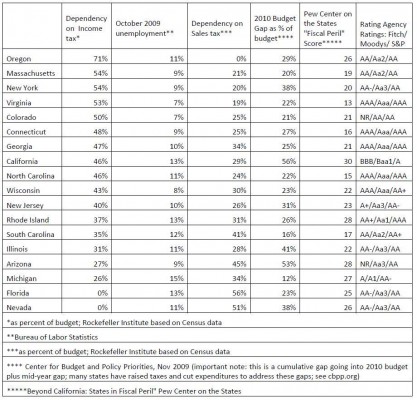State legislatures, required to balance their budgets, are up against the wall. Budget gaps have worsened mid-year. When you total the gaps going into the budget for FY2010 with mid-year fissures you come up with more than $190 billion according to a recent report from the Center for Budget and Policy Priorities. This is after the benefit of the federal stimulus monies. (Note that many states have either raised taxes or cut the budget to address the pre-budget gaps – CBPP has several studies on these actions. The National Conference of State Legislatures also chronicles the current status of budget gaps.) Another think tank, the Rockefeller Institute, looked at the revenue side of the gap and how states are coping with the current recession. State revenues, compared with local government, are more volatile, reacting faster and deeper in the current recession. Sales and income taxes are most volatile. Also volatile, but a smaller percent of the budget are capital gains taxes and the all-but-gone mortgage recording taxes. With most economists predicting a jobless recovery, income taxes and sales taxes are likely to remain depressed for some time.
Along with CBPP and the Rockefeller Institute, the Pew Center on the States recently published “Beyond California: States in Fiscal Peril”. Their own ranking consists of six factors: foreclosure rates, revenue declines, budget gaps, unemployment, money management and governing flexibility. On their ranking, “30” is worst, with California hitting that top target. They sound the alarm on several other states: Arizona, Nevada, Oregon, Florida, Illinois, Michigan, Wisconsin, New Jersey and Rhode Island.
The rating agencies have each of these states in the AA or AAA category, with the exception of California, New Jersey (Fitch only) and Michigan (Fitch/Moody’s). The Pew Study mentions that many of the state ratings on their list haven’t been reviewed in more than a year.
Ironically, local government is better off at this point in time. Property taxes are less volatile and are holding up so far in the recession. There is some misconception that the significant drop in property values translates directly into revenue loss. Many local governments assess well below full market value and re-assessments are done infrequently. Local governments that rely heavily on state aid will take it on the chin in the coming year and beyond as state’s cut their aid. School districts, public colleges and universities are vulnerable. On a relative basis, plain vanilla water and sewer systems (that were not built on speculation of new development) are among the stronger credits. Smart localities will set aside and protect surpluses now since they are last in the recession food chain.
We put together the following chart summarizing salient features of these studies. (CLICK THE IMAGE TWICE TO ENLARGE)

[…] ranks high among the states with large budget deficits and high unemployment. (See state’s post, and stress rankings chart) This is from Ballotpedia: On July 20, 2009 Gov. Ted Kulongoski signed […]